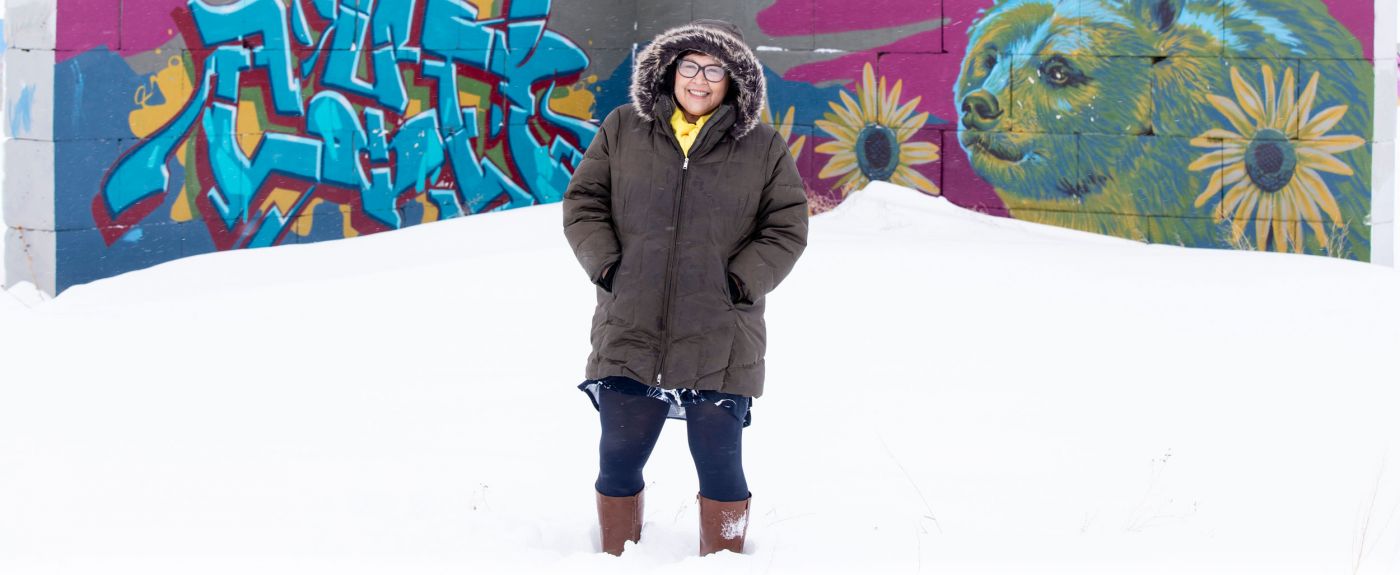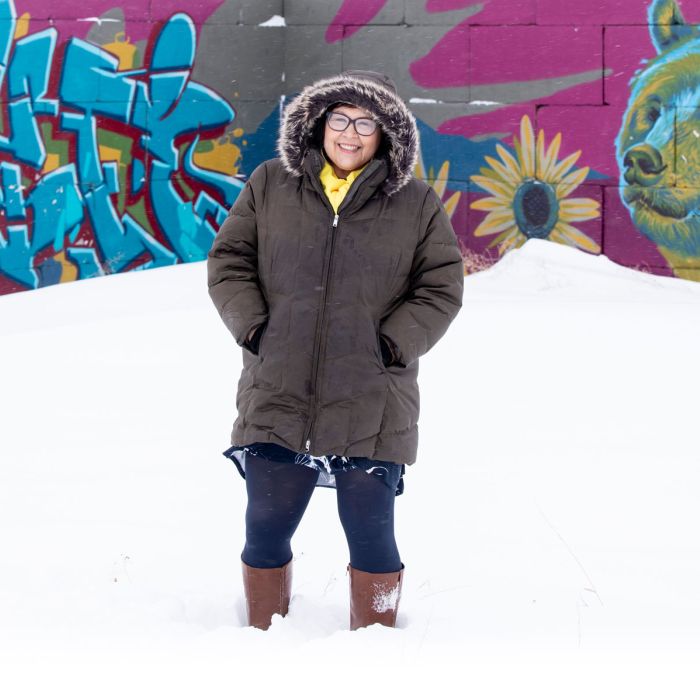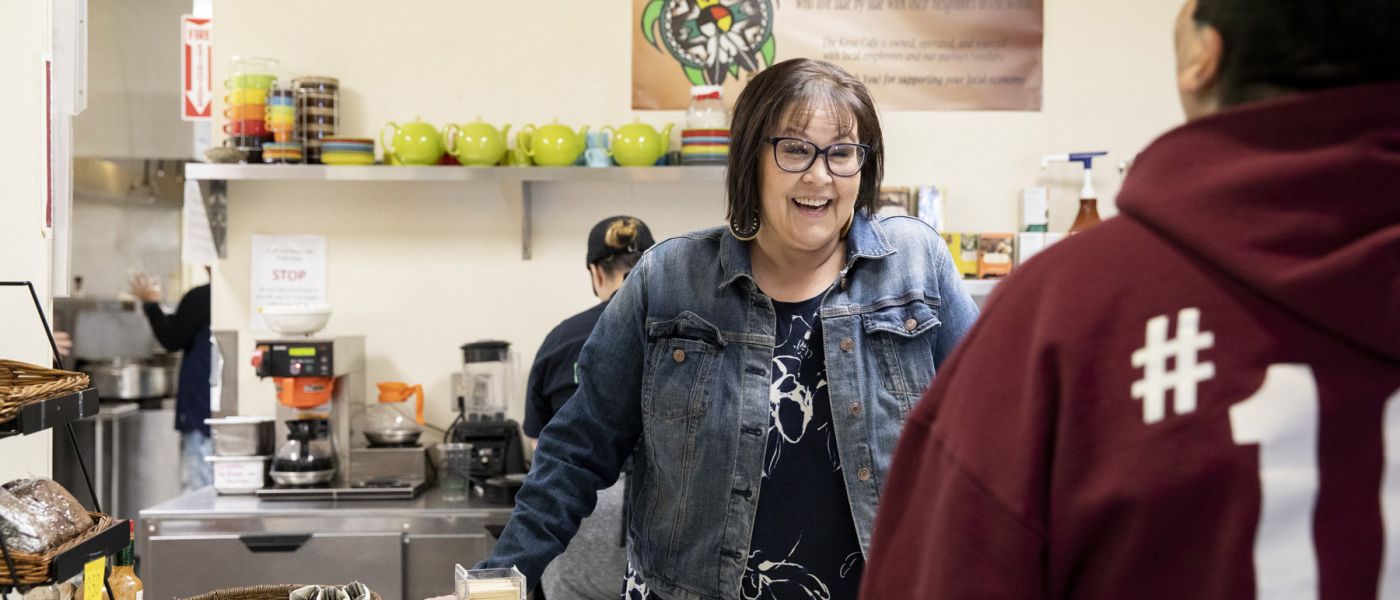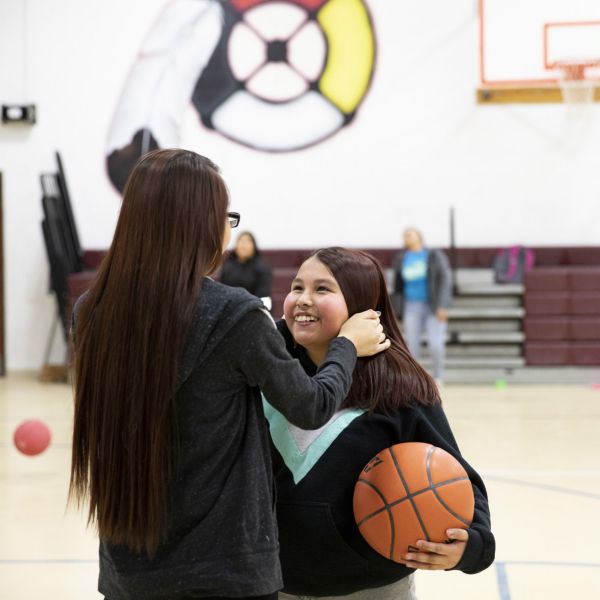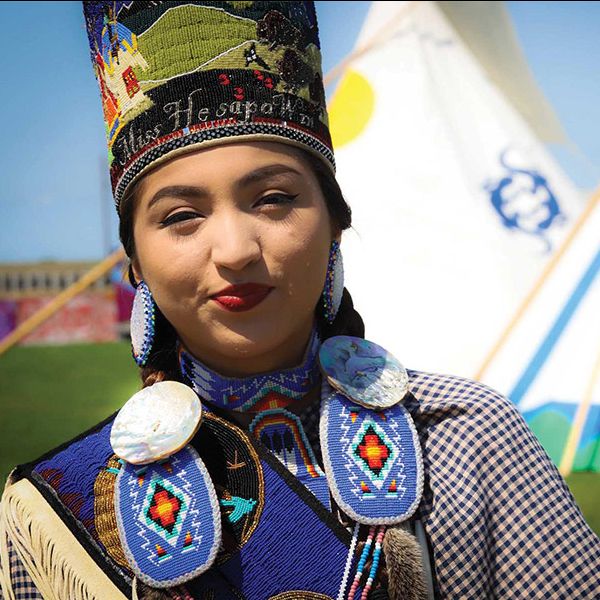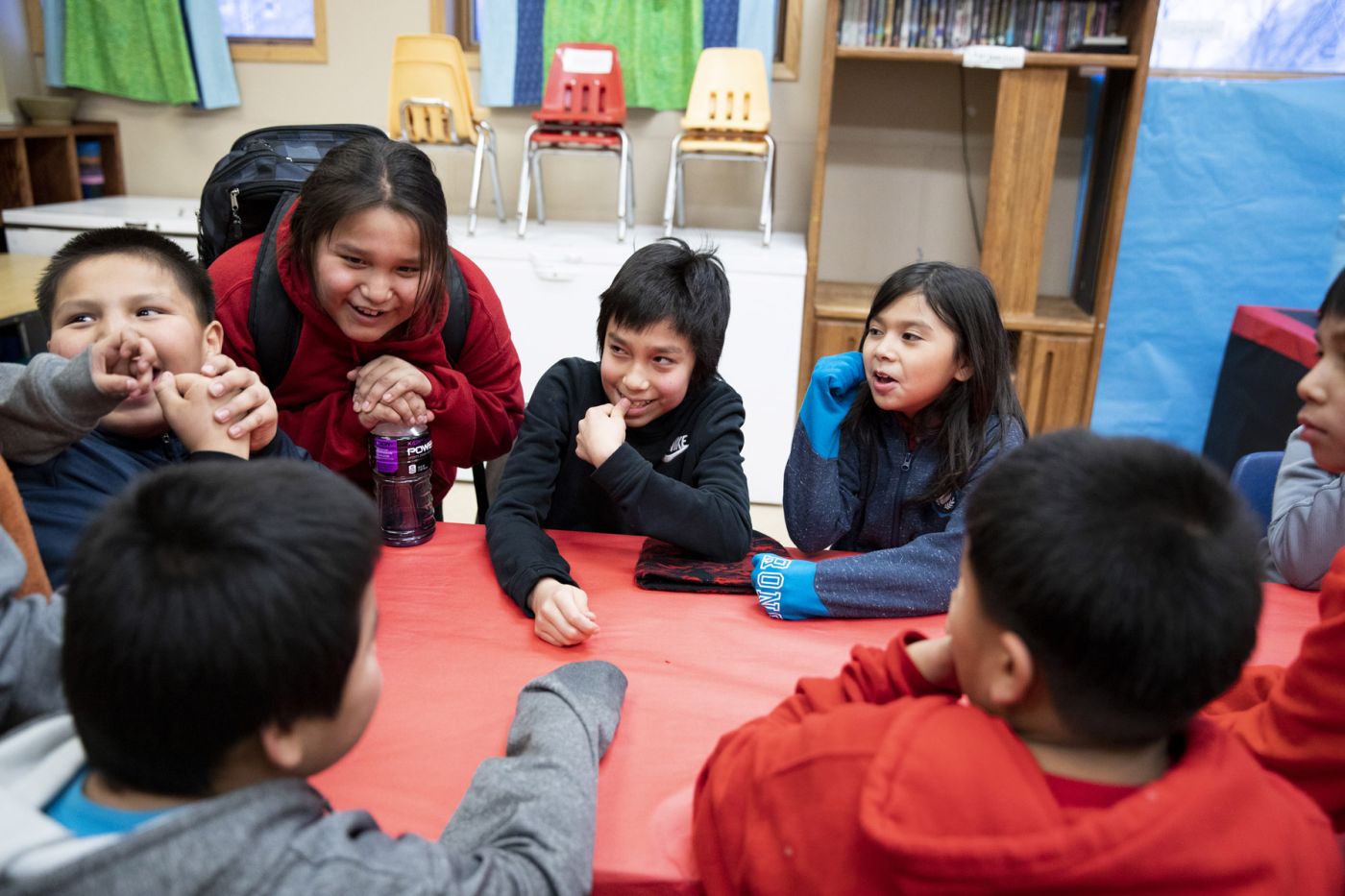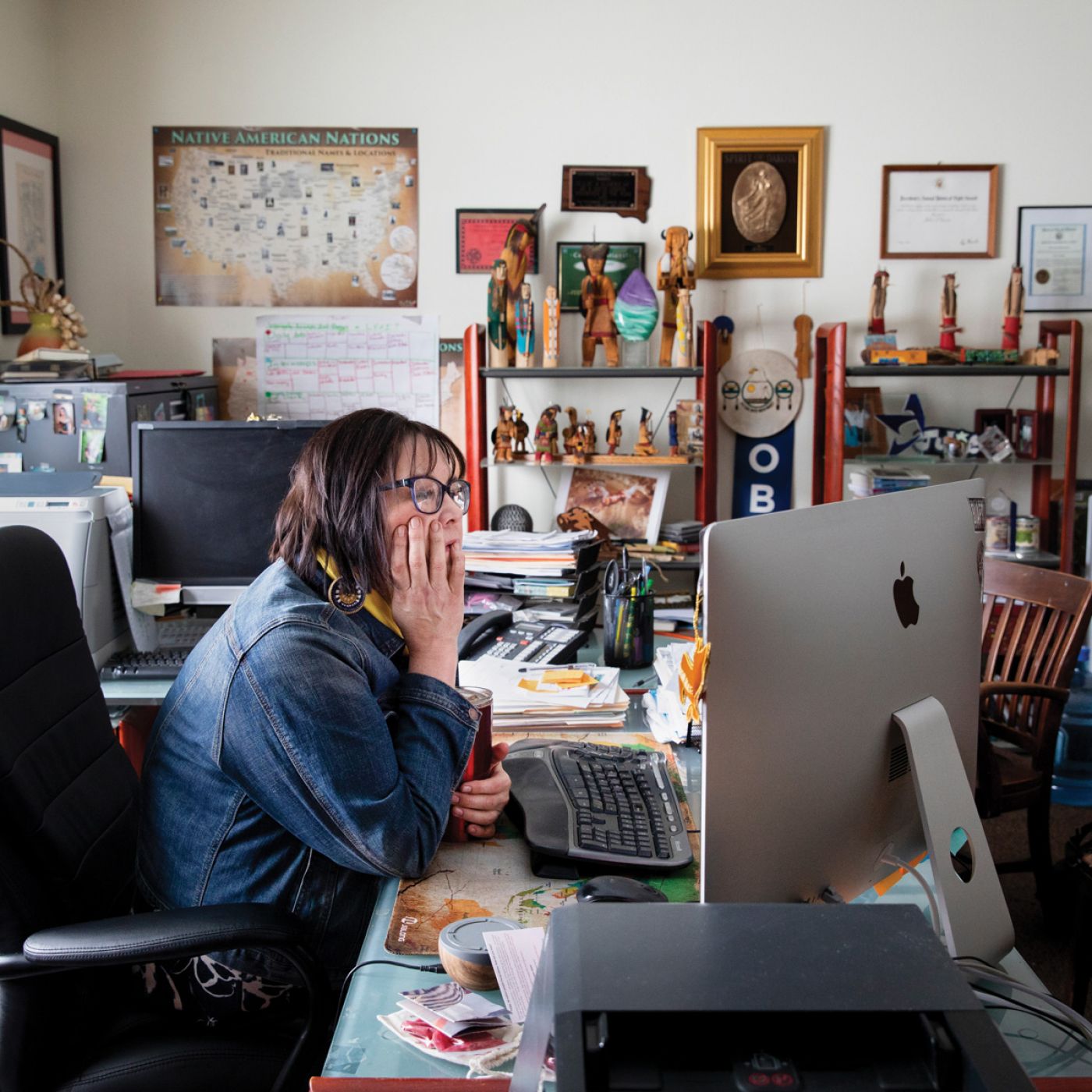Each summer, a vibrant public art space materializes on the windy rural plains of the Cheyenne River Reservation.
Eye-popping murals — ranging from abstract street art to cultural murals to political commentary pieces — come to life on cinderblock walls, shipping containers and more as part of the RedCan Graffiti Jam.
Put on by the Cheyenne River Youth Project (CRYP) in Eagle Butte, South Dakota, a town of about 1,350, the four-years-strong RedCan event is one way the organization is using art and culture to advance its goals of providing engagement, inspiration, new skills and quality of life for one of the country’s most poverty-stricken regions. Like CRYP’s many other initiatives, the event also emphasizes breaking the cycle of historical trauma for the Lakota people and instilling cultural pride. According to CRYP, about 3,600 people were directly and indirectly impacted during RedCan 2017.
“It’s really the one-and-only Indigenous graffiti jam in the country,” says CRYP founder and executive director Julie Garreau (BF’16). “It’s an innovative way to give back to the community and create culturally relevant art.”
Art is one of many visions of hope CRYP seeks to create in a community where many homes are falling apart, both structurally and interpersonally. Eagle Butte is in Ziebach County, where the poverty rate is 39% — almost three times the national rate, according to 2016 census data. For about 10,000 local tribal members, nearly half of whom are under 18, the poverty rate is 59%.
“Graffiti is an art that was born from the youth in communities that were struggling,” says Tyler “Siamese” Read (BF’17), a Rapid City artist who participated in the 2018 RedCan event.
RedCan is one of many participant-led CRYP collaborations serving a primarily Indigenous, small-town population. Responding to the needs of the community, CRYP’s programs span intramural sports, cooking, art, crafts, creative writing, web design, first aid, leadership, gang awareness and much more. CRYP’s tireless, innovative approach to problem solving has earned the organization consistent support from the Bush Foundation, including a 2015 Bush Prize and membership in the second Community Creativity Cohort in 2018.

"It’s an innovative way to give back to the community and create culturally relevant art."
Julie Garreau, Cheyenne River Youth Project executive director
Each day of RedCan starts and ends in a prayer circle. During one circle in 2018, a volunteer offered a quote by Aboriginal Australian artist, activist and academic Lilla Watson: “If you have come to help me, you are wasting your time. But if you have come because your liberation is bound up with mine, then let us walk together.” This sense of interdependence rather than charity has been a guiding principle for CRYP volunteers and instructors for the past three decades.
The Founding Mother’s Vision
The Eagle Butte of Julie Garreau’s youth had few creative and social outlets — no movie theater or bowling alley, and very few after-school activities. A member of the Cheyenne River Sioux Tribe, she saw her classmates being robbed of their childhoods, some turning to drugs and taking their own lives.
After graduating from Huron College in South Dakota — studying political science and criminal justice, with a minor in history — Garreau returned to Eagle Butte and decided to look for more ways to lift up the next generation of Lakota youth. She began a 15-year stint as the Cheyenne River Tribe’s education services specialist.
With support from the Tribal Council and volunteers from the community, she founded CRYP in 1988, and was a volunteer in the role for the first 12 years.
“I didn’t have this big, grandiose plan. I just didn’t,” Garreau says. “I just thought it was a good thing for kids to have a place to go, and I could do it. I had the energy, I had the time, I had the interest and I was raised to serve my community. That’s what I’m supposed to do. What they are absolutely guaranteed when they come here is that they will be loved, honored and respected. And they will be allowed to be kids.”
CRYP serves participants like Dawnelle Gartner, a 16-year-old sophomore in high school, who has to watch her two younger brothers while her father picks up extra work. “It’s kind of hard to find people that are cool without doing drugs,” she says, noting that some fellow students are using drugs regularly.
“Kids grow up a little too fast here,” Garreau continues. “Sometimes older kids are taking care of siblings, maybe something is happening with their parents. They taught me so much about myself and they taught me so much about my community through our interactions. I was working with post-secondary education, but somewhere along the line I realized we needed to get kids through 8th grade and high school, and they needed safe spaces, so that became more important to me. That’s where I belonged.”
Among her goals: tackling community challenges with creative solutions and developing those safe spaces for, and with input from, the youth of Eagle Butte. During Garreau’s time working for the Tribe, she also served on the local police commission, including three years as the chairperson, and she worked as a field coordinator for Running Strong for American Indian Youth.
“I wish we could bottle Julie Garreau or do a little cloning, because she has a way with the world that would very much benefit her contemporaries,” says Ren Dietel of Dietel & Partners, a philanthropic advisory group that supports quality of life efforts all over the world, including CRYP.
Starting CRYP was also an opportunity to build something based upon Lakota values: courage, wisdom, generosity and respect. As described in CRYP’s 2015 Bush Prize application, the organization embodies “The courage to move forward against daunting odds. The wisdom to listen to our children, families and community so we can develop programs that are culturally relevant and yet embrace contemporary issues. Respect for those we serve, so our programs honor them. Generosity, even when we have little to give.”
Spaces for Youth to See New Possibilities
Today, turning off Highway 212 and heading toward the Cheyenne River Youth Project on the edge of Eagle Butte is like approaching a complex for an alternative-learning school. The first things you’ll notice are a newly built playground and the two-and-a-half-acre garden that was originally developed in the mid-1970s by Garreau’s mother, Iyonne, who worked as the executive director of the Cheyenne River Elderly Nutrition Center. The garden continues to provide traditional, nutritious foods for adults, and brings Lakota children closer to the earth.
“My mother was a magical woman,” Garreau says. “She was vibrant and well-spoken and a force to be reckoned with. She was one of the most kind, compassionate people I’d ever met. She used to say that if there could be community gardens everywhere, it would begin to address all these health issues that we have. Because, of course, working with elderly, you saw all those health issues playing out.”
The garden is now named after Iyonne’s Lakota name, Winyan Toka Win, which means “Leading Lady.” CRYP took over planting, maintaining and harvesting the garden in 2000, two years after moving from downtown to their current facility, affectionately called the “Main.” In 2006, it dedicated a second facility, the Teen Center.
The original Main youth center space was in a converted building that used to be a bar in downtown Eagle Butte. Like many initiatives that followed, it was a symbol to show that alternative options beyond alcohol and drugs existed for area youth. “We remind the children who they are and talk about character and our values system instead of putting up signs that say ‘don’t do this, don’t do that,’” says Garreau.
Over the past three decades, CRYP has been able to expand its footprint — with support from the Bush Foundation, a partnership with Running Strong for American Indian Youth and other donations — and it’s now based in an enhanced facility built in the late ’90s. There’s the Main, which includes an activity space for younger children and the kitchen where meals are prepared for CRYP participants. Next door is the Ċokata Wiċoni (“Center of Life”) Teen Center, a programming space that’s home to offices, the Keya Café (sourced from the garden) and a gift shop. A hallway leads to a gymnasium covered in graffiti art created by visiting artists, and the wellness center, filled with workout machines and lifting equipment. There’s also an art room, a library and a computer lab. Beyond the building is the Waniyetu Wowapi (“Winter Count”) Art Park, which features a pictographic record of community history. Dedicated in 2015, it’s where RedCan is held each summer.
Every new CRYP program or feature begins with a discussion among the staff and youth participating in the organization. “Our approach is more organic,” says Anthony Potter, youth programs assistant. “We talk to the kids, and then we find an approach that works for them — not based on a guideline, some set of rules or someone who has never lived here.”
A native of Eagle Butte and a nephew of Garreau, Potter and his siblings grew up spending plenty of time at the original Main building. The son of a single mother, he grew up in one of the tougher neighborhoods of Eagle Butte where poverty, drug use, alcoholism and suicide were common. In his role at CRYP, he can connect with the youth because he lived the day-to-day adversities they endure. After leaving for college to pursue a degree in criminal justice, he has returned to run the CRYP book club and help with other programs and activities.
A glance at the “News” tab on the constantly updating CRYP website illustrates that the spaces are hubs of activity year-round. Youth participants have a wealth of events to choose from, and many of the initiatives are focused on teaching the value of giving back to the community. The youth and families are not CRYP clients; they are kin.
“It’s not some separate entity that comes from a Washington, D.C., organization,” says Garreau. “We’re grassroots. I always say ‘We’re for Cheyenne River, by Cheyenne River.’ We are lifting ourselves up. We are creating something that helps us and addresses challenges. We’re raised to believe that taking care of your community is important.”
CRYP does a lot with its limited funds and small staff. Dietel considers CRYP as a “best in class” for Indigenous youth programs and has continued to guide funding to the organization since 2012. “When you get to these spaces and meet these people, you see what they are doing is amazing with next to nothing,” Dietel says.
A prime example of the efficiency at play is the garden. The food feeds CRYP participants but is also used for a number of fundraising initiatives. There’s produce for farmers market sales, canned goods sold in the gift shop, hot meals sold in the Keya Café and, soon, a grant-funded food truck. But the garden is also a teaching aid to help the youth understand food sovereignty, nutrition and how to develop and sell all those products.
“In the very beginning we didn’t have anything,” Garreau recalls. “So if we had a roll of quarters, I had to be really resourceful with that. How could I make it two rolls of quarters, and how could I make that spread as far as I could? So a lot of those things are still very present in how we do business today.”
Internships That Show the Big Picture
In 2017, the mini-documentary “Lakota in America” was released by Square. It details CRYP’s Teen Internship Program through the eyes of Genevieve Iron Lightning, a teenage descendant of Lakota Chief Iron Lightning, who fought in the Battle of the Little Bighorn. Since 2013, the program has helped show young members of the Eagle Butte community firsthand what career options beyond working the local fast food chains look like.
Through her internship, Iron Lightning learned about entrepreneurship through the arts while being able to also weave in her Lakota heritage. She worked with Scape Martinez, a California-based artist and multi-year CRYP volunteer, to create her own spray paint brand and aesthetic that tied back to her cultural identity. “I don’t want their perfection, I want their expression,” Martinez says. “I would like the young people who take my classes to know that whatever they can think of they can execute and put out into the world.”
In addition to paid arts internships, there are positions focusing on wellness, social enterprise, retail skills and horticulture. The internships continue evolving to suit the community’s needs and the times. Combining professional and personal growth, the experiences are meant to provide mentoring and teach skills that participants can apply to both future employment and their emotional well-being. From Rapid City Arts to National Relief Charities to the Black Hills Wannabees, the collaborative energy shared by other organizations has created one-of-a-kind experiences for CRYP participants.
For the Native food sovereignty internship, students learned customer service skills from the Native business Painted Sky Consulting and received gardening training from the Intertribal Agriculture Council. The social enterprise internship included financial literacy courses taught by Four Bands Community Fund (2013 Bush Prize winner). With classes based upon “The Sioux Chef’s Indigenous Kitchen” cookbook by Sean Sherman (BF’18), the Indigenous foods cooking internship taught by Anthony Potter was added in 2018, allowing students to connect to their heritage through the ingredients, methods and recipes.
“He’s quite the chef, and what he’s learned about Indigenous foods is amazing,” Garreau says of Potter. “He teaches them how to make things our ancestors would have eaten. I love that. It’s exciting that our kids are learning that and he’s learning with them. He had to do the research and planning. I like that with all of my staff. Each of them takes an active role in facilitating the different internships.”
More than 600 community members have taken part in internships, and the programming has touched “thousands and thousands” of kids over the past 30 years, according to Garreau. With an annual budget of $1-1.2 million, continuing the work has long included partnerships with like-minded organizations.
Interns have used their newfound skills to bolster their resumes and college applications as well as to enhance aspects of their daily lives. “CRYP is special because it offers young kids like me the opportunity to create our job and people skills, so we can build a better future for ourselves,” says Mason Arpan, who has participated in food sovereignty and social enterprise internships. Arpan used internship stipend funds to buy a new lawn mower for his local lawn-care business.
“It’s about the kids having more opportunities and expanding their futures for their culture,” says Jerica Widow, youth programs director. “Sometimes it’s about planting seeds,” Garreau adds. “Sometimes it’s a skill you can go and do.”
"Kids are more capable than we imagine. They are thinking, intelligent, amazing people. They know what’s off-center in their communities. We need to ask their opinion."
Julie Garreau
Envisioning a Future for CRYP
Julie Garreau’s hope is that the work of the CRYP continues for decades to come. Over the past five years, she has started discussions with her staff about a transition plan for when she retires. Part of the focus of her 2016 Bush Fellowship was to take time to expand her understanding of Lakota culture and language, as well as to learn more about Western leadership. With those tools, she’ll be better equipped to hand off CRYP leadership duties to a new generation. Her journey has led her to the realization that there are tradeoffs: allowing work to be all-consuming can be a deterrent for self-care, and many ways to lead are in conflict with tribal values.
“Most often Western leadership models teach about growing yourself; moving up in your position; and definitely about a hierarchy,” Garreau wrote in a learning log, a monthly reflection from her Fellowship. “In processing what I’ve learned to determine how can I adapt this information and make it relevant in my community, I’ve come to the conclusion that I have to find balance to be most effective.”
In 2017, CRYP partnered with the Washington, D.C.-based Center for Native American Youth (CNAY) at the Aspen Institute. Garreau traveled to D.C. that year to attend CNAY’s Champions Week event and brought back a new leadership opportunity based upon CNAY’s Champions for Change program, which trains young people to improve the lives of their fellow youth in Native American communities. The Growing Into Wowachinyepi (“one whom the people can depend on”) program teaches CRYP interns Western leadership skills that still pay respect to the Lakota Nation. After a one-year youth pilot project, the two organizations plan to develop a sustainable local program and a larger national technical assistance program.
“It was really successful, at least for the first year,” says Garreau. “We want to find funding to keep developing it. Kids are more capable than we imagine. They are thinking, intelligent, amazing people. They know what’s off-center in their communities. We need to ask their opinion. One day they’ll be taking care of us, running this country or tribal government. Our obligation is to give them skills: leadership, decision making, communication through art, whatever it is.”
“We’re trying to build healthier kids as a whole,” adds Widow. “We need to let them have a voice and get them comfortable to say what they want to say.”
The first five participants entered into a boot camp to learn about advocacy, needs of the community and public speaking. They traveled to Washington, D.C., and met with staffers for South Dakota Senators John Thune and Kristi Noem (now the state’s newly elected governor), and with Senator Mike Rounds. During these meetings, the CRYP youth were able to discuss topics that affect their community — such as opioid abuse, funding for addiction prevention and tribal advocacy — and they discussed goals for developments in the future.
The Growing Into Wowachinyepi program exemplifies many important investments into a new generation of CRYP, and there will always be more work to be done. Along with cultural growth, there are plans for technological growth at CRYP through a computer lab with programs in programming, coding and graphic design. (Currently, students learn to edit on iPads, and there aren’t enough yet for large classes.)
CRYP’s future, like its past, will grow in the forms that best suit the children who fill its classrooms, hallways and outdoor spaces. “My Bush Fellowship journey is not about me,” Garreau noted in a learning log. “It’s about investing in me so I can help my community. In the end, I simply want to be a Good Ancestor, whose legacy endures in a healthy, strong Lakota Nation.”
Sitting in her office on a fall afternoon, Garreau observes that, “Each of us are community members,” she says, emphasizing that the community is small.
“Believe me,” she adds, laughing, “people have no problem calling us and letting us know if they feel that we’re heading in the wrong direction. We all represent families, clans and groups. We’re having these conversations and talking to people all the time.”
